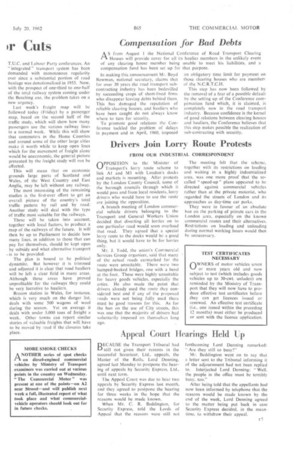Railways Publish Bluepr
Page 38

Page 39

If you've noticed an error in this article please click here to report it so we can fix it.
or Cuts
BY S. BUCKLEY
1_IAULIERS are likely to be left with a clear field in many parts of the country I hf Dr. Beeching gets his way over reshaping British Railways. He is going to ask for drastic reductions. This became obvious with the publication last Friday of the first of the British Transport Commission's traffic studies.
"Clearly many lines are so slightly used as to make it obvious their future will have to be considered. . . We hope to be able to announce the early stages of the plans for reshaping the railway system towards the end of this year. . . . It will be a political decision as to how far they are implemented."
This is the crux of the comment made by the Commission in the notes accompanying the publication last week of a map showing the density of freight traffic of British Railways. It has been compiled from data provided as part of the traffic studies instituted by Dr. Beeching last year.
The map portrays the British Railways system relative to density of freight traffic. Five grades of density are denoted: namely up to 5,000 tons; 5,000 to 10,000 tons; 50,000 tons; 100,000 tons; and 200,000 tons per week.
Of the 18,400 miles of lines open to traffic, 30 per cent, of the route mileage carries only 1 per cent. of the total freight traffic, whilst 95 per cent. of the traffic is carried on only half the system.
Studies have been proceeding since last year to ascertain the total pattern of traffic movement, either by rail or by road, and what traffic is potentially suitable for rail. The publication of this freight map and relevant information last week is the first result of the studies.
There is a striking disparity between the heavily and lightly loaded lines shown on the map but, to what ever extent they are used, railway lines are expensive operate and maintain.
Additionallythe studies reveal th some fines which are at present well usl may not be the most suitable and.efficie routes for the traffic passing over the] Where towns or cities have more th; one freight centre, the need for retainii them all will be examined.
The B.T.C. state that they are form lating plans as for a commercial made taking and these will be published soon as they are known. Their impl mentation will be a political decision as the trades unions will be kept inforrne
With a movement of 50,000 tons more per week taken as a rninimu acceptable standard, the map reveals thi as is to be expected, a high proporti( of such lines fall within an area wi London, Bristol, Liverpool and Grimsl forming the extremities.
Outside this area there is sha reduction in the number of lines in category. In the north of Scotland, f example, these are limited to the ma lines to Aberdeen and Inverness and the West Country, beyond Exeter, to ti main line as far as Par. Except for ti Cardiff and Swansea areas practically Wales is without lines averaging 50,01 tons or more of freight per week.
Our Industrial Correspondent writs Publication of the first of the trail studies ensures that transport policy w become one of the hottest issues at tl T.U.C. and Labour Party conferences. An " integrated " transport system has been demanded with monotonous regularity ever since a substantial portion of road haulage was denationalized in 1953. Now, with the prospect of one-third to one-half of the total railway system coming under the Beeching axe, the problem takes on a new urgency.
Last week's freight map will be followed today (Friday) by a passenger map, based on the second half of the traffic study, which will show how many passengers use the various railway lines in a normal week. While this will show that commuters in the Home Counties and around some of the other large cities make it worth while to keep open lines which for the movement of freight alone would be uneconomic, the general picture presented by the freight study will not be affected.
This will mean that on economic grounds large parts of Scotland and Wales, of the West Country and East Anglia, may be left without any railway.
The most interesting of the remaining studies is the first-ever effort to get an overall picture of the country's total traffic pattern by rail and by road.' Another study will deal with the type of traffic most suitable for the railways.
These will be taken into account, together with local factors, to produce a map of the railways of the future. It will then be up to Parliament to decide how many lines, in addition to those that can pay for themselves, should be kept open by subsidy and what alternative transport is to be provided.
The plan is bound to he political dynamite. But however it is trimmed and adjusted it is clear that 'road hauliers will be left a clear field in many areas. Although these areas have proved unprofitable for the railways they could be very lucrative to hauliers.
Brecon station in Wales, for instance, which is very much on the danger list, deals with some 500 wagons of wool during the season. Yet on average it . deals with under 5.090 tons of freight a week. Other towns can report similar
stories. of valuable freights that will have to be moved by road if the closures take place.




















































































































